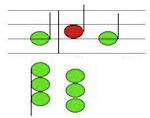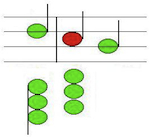
HARMONIC EXPANSIONS
CHAPTER 2: NONHARMONIC TONES
2.4 Accented Neighbor and Passing Tones
 |
 |
 |
The above video and score illustrate an accented upper neighbor in "Toreador" from Bizet's opera, Carmen. On beat 2 of the first measure the nonharmonic tone, D, is approached and left by step, first rising from the chord tone, C, and then resolving in the opposite direction back to C.
The video of the score on the right continues with a repetition of the phrase, but this time without the upper neighbor. Notice how much more bland this version is.
Also notice and listen for the neighbor tones G and B circling around the chord tone, A, in measure 3. These dissonances, when used correctly, actually reinforce the harmony rather than obscure it.
| Accented Neighbor and Passing tones, then, can be illustrated with the graphics to the right. These graphics show passing and neighbor tones on the first beat of the measure, but other beats may also accompany these nonharmonic tones (see the "Toreador" example above). If you encounter a chord that does not seem to be a triad, or even a seventh chord, when analyzed vertically, look for a chord tone immediately following the chord. An accented nonharmonic tone may have replaced the chord tone. |
 
|
|
|
In four voices, the two expanded fundamental harmonic progressions to the left show
|
As a final example listen to the accented chromatic passing tone over dominant (seventh) harmony in Mozart's Piano Concerto No. 21:
 |
 |
 |
 |
 |
Comments? Click here. |



